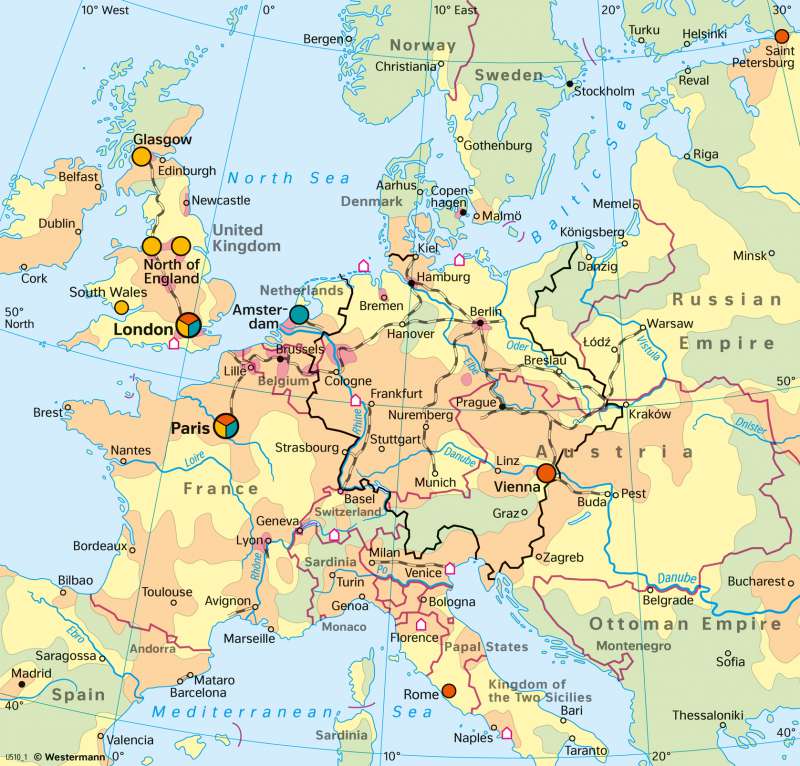Europe - Early industrial centres circa 1850
Economy
978-3-14-100890-6 | Page 64 | Ill. 1

Overview
In the late 18th century, the industrial revolution began, slowly at first, which fundamentally changed people's living and working conditions. Characteristic features of the process that transformed traditional agrarian societies into modern industrial societies were the intensive use of coal and iron, the start of mass production with massive use of new machines and manufacturing processes, and a sharp increase in wage labour, which in turn led to a serious population shift from rural areas to the explosively growing cities. A direct consequence of this development was the impoverishment of large sections of the population. The "social question" in turn played a strong role in the emergence of the labour movement.
England and continental Europe
The Industrial Revolution began with technical innovations, including the invention of a spinning wheel with several spindles ("spinning jenny") in 1764. Only one year later, James Watt succeeded in making a decisive improvement to the steam engine, which made it possible to pump groundwater out of mine tunnels, allowing workers to access coal at much greater depths. Above all, it soon became apparent that the steam engine could be combined with a wide variety of machines, including looms, spinning machines, saws, milling machines, drills, or others. One year after the invention of the steam engine, the first blast furnace was built in England, and other ground-breaking innovations followed at intervals of a few years.
Around 1850, the three main reasons for the economic upswing were the textile industry, the iron and steel industry, as well as mechanical engineering and increasingly also vehicle construction. The heavy industries were without exception located in the close to important coal deposits. The leading industrial power in Europe was by far Great Britain, especially concerning hard coal production, pig iron production and the number of steam engines and steam-powered spinning machines in operation. France followed in second place in industrial production, while industrialisation in Germany began with a delay for historical and political reasons. The German Confederation was not a modern, centrally organised country, but a loose confederation of states in which small-scale statehood and internal German borders slowed down the economic upswing, despite the ground-breaking founding of the German Customs Union in 1834. The development of the Ruhr region into a leading industrial region was still in its infancy. Dortmund and Essen, the two largest cities, were still relatively insignificant with around 10,000 inhabitants, Gelsenkirchen with 800 inhabitants was a village. In 1849 the first blast furnace, heated with coke, had just been built in Mülheim, but many more quickly followed.
Cities and transport
The revolutionisation of transport, began in 1807 with the invention of the steamship. It was crucial to the industrialisation process because it was the only way to transport large quantities of raw materials from the mining areas to the factories and goods from there to the markets. The railway played a key role in speeding up the movement of people and goods. Here, too, England took a leading role. The first passenger steam railway ran between Liverpool and Manchester in 1830, soon followed by connections to Glasgow and London. In 1835, the British rail network covered 700 kilometres, and by 1850 it had grown to 8000 kilometres. Other countries also pushed ahead with the expansion of their rail networks. In Germany, the first steam railway ran from Nuremberg to Fürth in 1835. In 1837 construction began on the first long-distance railway line between Leipzig and Dresden, and by 1850 the German railway network had an operating length of around 7000 kilometres.
The most important cities of the time were London, at that time the largest city in the world, Paris, in cultural terms the "capital of the 19th century" (W. Benjamin), Amsterdam due to its port and its importance as a trading centre, and last but not least Vienna as the seat of the German Confederation.
The negative consequence of the technical-economic upswing was a drastic impoverishment of broad sections of the population in the rapidly growing poor quarters of the cities. Because of the automation of production, many skilled workers were not needed anymore, and the rural exodus led to an oversupply of labour. Countless unskilled workers, as well as women and children, were hired at starvation wages.




